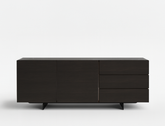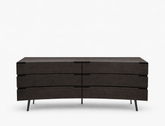Refresh Your Home with Contemporary Interiors

Interior design is an ever-evolving field that constantly redefines trends and styles to keep homes looking fresh and up-to-date. Among these trends, "contemporary interior design" has gained significant traction, offering a perfect balance between modernity and timeless elegance. This design style has been making waves in both HDB and BTO homes, and it continues to dominate the glossy pages of design magazines, as well as social media feeds. Whether you're refreshing your current space or designing a new home, contemporary interior design offers an aesthetic that is worth exploring.
Contemporary interior design thrives on the principle of minimalism fused with functionality and sophistication. It embraces simplicity while paying attention to both form and function. Before you dive into transforming your space, let’s explore the key elements of contemporary interior design and how you can incorporate them into your HDB flat.
What is Contemporary HDB Interior Design?
If you want a space that feels current, stylish, and comfortable, contemporary interior design is the way to go. Unlike other design themes, contemporary design doesn’t have rigid rules—it adapts to the current trends and can be influenced by various styles, including modernism, minimalism, and Scandinavian design.
Incorporating materials like glass, steel, and natural elements such as wood and stone is a hallmark of contemporary design. The furniture in these interiors often features clean, simple lines, with an emphasis on comfort and practicality. This blend of minimalism and functional design has made contemporary interiors a popular choice in Singapore's homes, especially for HDB and BTO flats.
Key Elements of Contemporary Interior Design
Clean Lines and Minimalism
A defining feature of contemporary interior design is the use of clean lines and uncluttered spaces. To achieve this, it’s essential to declutter your home and remove any unnecessary items that contribute to a chaotic look. The furniture and décor should be simple and streamlined, avoiding ornate or overly complex designs. Opt for pieces that exude sophistication through their simplicity, creating an open and spacious environment.
The emphasis on minimalism doesn’t mean sacrificing comfort; instead, it’s about curating the essential pieces that enhance the room without overwhelming the senses. Clean lines in furniture, cabinetry, and lighting fixtures contribute to the overall polished feel of the space.
Neutral Colour Palette
A neutral colour palette is key when crafting a contemporary interior. Commonly used shades include soft whites, warm beige tones, and cool greys, which together create a calming and understated backdrop for your space. These colours allow your furniture to take centre stage, enhancing its visual appeal without distracting the eye.
To elevate the contemporary feel, you can incorporate accents of black or metallics, which add a touch of contrast and drama to the space. For homeowners who prefer a bolder aesthetic, a pop of colour like a vibrant throw pillow or piece of artwork can also be introduced. However, it’s important to maintain balance—too many bold colours can disrupt the serene atmosphere that contemporary design is known for.
Clever Use of Texture and Contrast
While contemporary interiors are known for their minimalism, they are far from dull. Adding texture and contrast is an effective way to introduce depth and visual interest to your design. This can be achieved through the smart use of materials such as textured rugs, soft cushions, and woven throws.
Pairing contrasting elements, like a sleek black sofa against a crisp white wall or a polished wooden coffee table with a metal frame, also creates an engaging and dynamic space. The goal is to keep the room visually interesting without compromising on the minimalist aesthetic.
Sleek and Functional Furniture
In contemporary interior design, furniture should not only look sleek but also serve a purpose. Multifunctional pieces are particularly popular in smaller homes such as HDB flats, where space-saving solutions are essential. Examples include coffee tables with hidden storage, sofas that convert into beds, or dining tables that can be extended when needed.
Material choices also play a critical role in contemporary furniture design. A mix of wood, glass, and metal elements can give your home a modern edge. However, balance is key—overusing certain materials may cause the room to feel cluttered or too busy. Stick to streamlined furniture that complements the overall aesthetic without overwhelming the space.
Well-Curated Art and Accessories
Although contemporary interior design emphasizes minimalism, that doesn’t mean you have to forgo personal expression. Art and accessories can elevate a space, provided they are curated thoughtfully. The rule of thumb is quality over quantity—choose pieces that reflect your personality and style, but don’t over-accessorize.
A large abstract painting on the wall or a statement sculpture on a sideboard can inject character into the room. Keep accessories to a minimum to prevent clutter. A carefully curated selection of decorative items can make your space feel cohesive and well-designed without appearing overly busy.
Statement Lighting
Lighting is a critical element in contemporary design, influencing both the ambiance and functionality of a room. When selecting light fixtures, opt for sleek, modern designs such as pendant lights, track lighting, or recessed lighting. Dimmers can also be installed to allow you to adjust the lighting according to the mood.
Incorporating natural light is equally important. Large windows that allow sunlight to flood in can brighten up a contemporary space and create an airy atmosphere. Window treatments should be kept simple, using blinds or sheer curtains that don’t detract from the room’s clean lines.
Contemporary vs. Modern Interior Design
Although "contemporary" and "modern" are often used interchangeably, they refer to distinct design philosophies in interior design. Modern design hails from a specific era, primarily the early to mid-20th century, and is characterized by functional minimalism and industrial materials like steel and concrete.
Contemporary design, on the other hand, refers to the current design trends of the time. This design approach is more fluid and evolves with changes in style preferences, allowing for a mix of materials and elements, from bold colours to natural textures. Contemporary interiors tend to focus more on comfort and livability, while modern designs can feel more formal and austere.
In essence, contemporary design is an ever-changing reflection of the present, whereas modern design is rooted in a historical context.
Takeaway
Contemporary interior design offers a stylish, sophisticated, and highly functional aesthetic that is perfect for modern homes, including HDB and BTO flats in Singapore. By incorporating the key elements such as clean lines, a neutral colour palette, textured accents, and multifunctional furniture, you can create a space that not only looks great but also feels comfortable and inviting.
If you're looking for contemporary furniture that complements this design style, Prestige Affairs Furniture offers a wide range of sleek, trendy pieces that are sure to enhance your home. From chic sofas to minimalist coffee tables, their curated collection provides the perfect foundation for your contemporary design vision. Visit their website or showroom today and take the first step towards revolutionizing your home interior.
FAQs about Contemporary Interior Design
What are the main features of contemporary interior design? Contemporary interior design is defined by clean lines, minimalism, and a neutral colour palette. It incorporates a mix of natural and industrial materials such as wood, glass, and steel, with a focus on functionality and style.
Can I add bold colours to a contemporary design? Yes, you can introduce bold colours to contemporary interiors, but it’s important to maintain balance. Bold accents should be used sparingly to avoid disrupting the overall calm and minimalist aesthetic.
How does contemporary design differ from modern design? While both styles emphasize clean lines and minimalism, modern design refers to a specific era (early to mid-20th century) and often features industrial materials. Contemporary design is more fluid and incorporates current trends, focusing on comfort and livability.
What type of furniture works best in contemporary interiors? Furniture in contemporary design should be sleek, functional, and simple. Multifunctional pieces, such as sofas with storage or extendable dining tables, are particularly useful in smaller spaces like HDB flats.
Where can I find contemporary furniture in Singapore? Prestige Affairs Furniture offers a curated selection of contemporary furniture that complements modern design themes. Their collection includes everything from statement-making sofas to minimalist tables, perfect for enhancing your contemporary interior.







